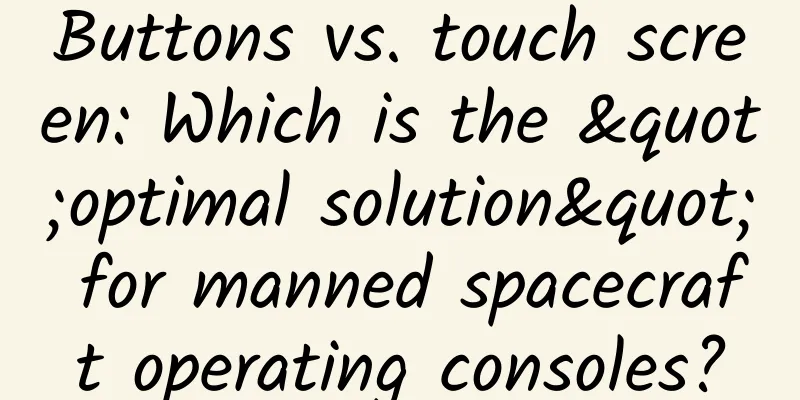Buttons vs. touch screen: Which is the "optimal solution" for manned spacecraft operating consoles?

|
In May 2023, the Shenzhou 16 manned spacecraft was successfully launched. Compared with previous manned spacecraft, Shenzhou 16 has two major changes: the first is that the localization rate of components will be higher, so as to achieve more comprehensive independent control; the second is that some improvements have been made to the instrument panel inside the spacecraft, making it more beautiful, more modern, and more suitable for astronauts to operate... In fact, this second point is more attractive to me. Because when I saw this possible upgrade point, the appearance of SpaceX's manned Dragon spacecraft immediately emerged in my mind. Comparing the only few manned spacecraft in the world today - SpaceX's Crew Dragon, Boeing's Starliner (although it has not yet been successful), and Russia's Soyuz - you can see some possible development directions for manned spacecraft in the future. The most typical contrast is between the Dragon spacecraft and the Starliner. Although both are products of the 21st century, the operating interface of the Dragon spacecraft looks much more sci-fi than that of the Starliner. The former's operating console is a few large screens, and there are almost no physical buttons. Human-computer interaction is completed through the touch screen. The latter's operating console, although it also has a screen, still retains a large number of densely packed physical buttons. It looks very traditional, just like the cockpit of an airplane. It feels mysterious and difficult to approach. So, why do the two companies adopt two completely different design ideas? What are the advantages and disadvantages of these two ideas? Which one is more in line with future trends? Let's discuss it a little. The picture comes from Tuchong.com First, let's take a look at the logic behind their choice of their respective technical routes. Boeing's logic for using more buttons may be: First, based on NASA's requirements: Boeing's Starliner is mainly designed for NASA's commercial manned program, and its main task is to safely send NASA astronauts to the International Space Station, so its design needs to comply with NASA's regulations and standards. In NASA's regulations, the control method of the spacecraft emphasizes reliability, stability and safety, and requires backup control methods and backup energy to ensure the safety of astronauts in emergency situations. Obviously, the traditional button-type operation method can provide a more intuitive, reliable and safe control method, which is more in line with NASA's traditional requirements for the control method of manned spacecraft. Second, influenced by experience and tradition: Boeing is a veteran company in the aerospace field with many years of experience and tradition. Among these traditions, the use of button-operated spacecraft control methods is more common, and Boeing may have been influenced by this tradition. In addition, Boeing itself has many experiences with aircraft and airplanes controlled by physical buttons, and this experience may have also prompted them to adopt button-operated operations in the design of the "Starliner" spacecraft. Third, the convenience of astronaut training: Since push-button operation can provide a more intuitive and reliable control method, the operator's learning and training time and cost may be less. In the space flight environment, astronauts' time and energy are very valuable, so simplifying the training process and improving operational efficiency may also be one of Boeing's considerations for choosing push-button operation. On the contrary, SpaceX's choice of touch screen operation also has its own logic: First, it is aimed at the needs of the commercial market. In addition to the manned Dragon spacecraft designed for NASA's commercial manned program, SpaceX also intends to explore the private space tourism market. In order to attract more private space tourism customers, it is necessary to provide a more modern, intelligent, and convenient user interface and control method to meet the personalized needs of customers. Touch screen operation can provide a more flexible and modern user interface and control method, which meets the needs of the private space tourism market. Second, the advantages of technology. With the development of electronic technology and the decline in prices, touch screen technology has been widely used, especially on devices such as smartphones and tablets. Compared with the traditional button-type operation method, touch screen operation can provide more flexible and diverse user interaction methods. In addition, touch screen operation can also provide more intuitive and direct feedback, allowing operators to understand the status and changes of the spacecraft more quickly. These advantages of technology may be one of the considerations for SpaceX to choose touch screen operation. Third, advanced automation technology. In SpaceX's design, many functions of the spacecraft are highly automated. Touch screen operation can be better combined with these automated functions, making the operation faster and more intelligent. In addition, touch screen operation can also provide a more intuitive and convenient way to diagnose and troubleshoot faults, improving the reliability and safety of the spacecraft. So overall, Boeing and SpaceX have reasonable logic and considerations behind their choice of different control methods, and are trying their best to improve the reliability and safety of manned spacecraft to meet the needs of different markets and applications. So the question is, which method is more in line with future trends? I think it may be the Dragon spacecraft. Because the manned spacecraft of the future may carry more than just professionally trained astronauts. Because commercial spaceflight is to send ordinary people to space. Therefore, in addition to safety and reliability; in addition to flexibility and sustainability; it must also have - a high degree of automation and intelligence: the automation system can reduce the burden on the flight crew and improve the efficiency and accuracy of mission execution. Intelligent technology can provide a more intuitive and direct interface and interaction method, improving the operating experience and mission execution capabilities of the flight crew. In addition, ergonomics and user-friendliness: its operating interface should be intuitive and easy to use, and be able to provide clear information feedback and operating instructions. At the same time, the layout and space design inside the spacecraft should optimize the comfort and work efficiency of astronauts. Obviously, all these comforts, from vision to operation to physical sensation, must be achieved by reducing the number of buttons. This article is a work supported by Science Popularization China Starry Sky Project Author: Science Rocket Uncle Reviewer: Zhou Binghong Produced by: China Association for Science and Technology Department of Science Popularization Producer: China Science and Technology Press Co., Ltd., Beijing Zhongke Xinghe Culture Media Co., Ltd. |
<<: What kind of fish is salmon? Can domestic salmon be eaten raw?
>>: What is the relationship between cherries, cherry blossoms, and cherries?
Recommend
New energy vehicle rural promotion campaign launched, ten companies offer discounts to third-tier and fourth-tier cities and below, with the highest discount of 8,000 yuan
On July 15, 2020, the Ministry of Industry and In...
The explosion of an atomic bomb produces light and energy, so how can energy and light be turned back into matter?
Minutes after the Big Bang, the first particles o...
Why do clothes that are dried in the shade smell so bad? The reason is...
When the rainy season comes, friends in the south...
Why are everyone looking forward to Google Play returning to China?
Google Play is coming to China, maybe it’s true! ...
360 search advertising promotion, keyword quality optimization skills!
What is keyword quality? Keyword quality represen...
Infected and in quarantine? Keep this list of items to keep!
Although the new coronavirus is rampant, don’t pa...
Brand Advertising Development Trends in 2022
"In the real market environment, 70% of sale...
Microsoft should have been the leader in smartphones, but why didn't it?
Earlier, the well-known technology blog ArsTechni...
Fang Cheng Bao 8 turns into Huawei system. Obviously, BYD's 1 billion monthly investment in intelligent driving is far from enough.
BYD and Huawei, two Shenzhen companies, did not o...
Android and Chrome merge, a win-win for developers and Google
[[122279]] For a long time, developers have often...
It would be so cool to go to work like Wu Lei every day!
Wu Lei’s cycling vlog is popular again. From the ...
Quantitative Learning Cloud Lecture Hall Wang Yan's Four-dimensional Three-first Selection and Following the Banker Basic Training Class 30th
: : : : : : : : : : : : : : : : : : : : : : : : : ...
NetEase’s marketing methodology for screen-sweeping!
To swipe the screen once may be luck, but to swip...
Useful information + cases | In-depth analysis, how to punch in and sign in effectively?
What I want to share today is “punching in and si...









